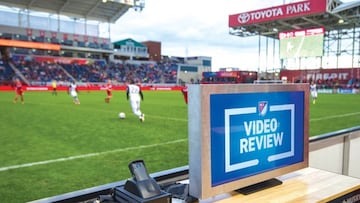As in Liga MX and MLS, Video Assistant Referees will be in use in the Leagues Cup. Here’s how they work.
Roddy ConsRoddyConsUpdate: Jul 20th, 2023 11:32 EDT

Getty Images
Some people love it, some people loathe it, but it seems as if the Video Assistant Referee (VAR) is here to stay. Many nations around the world have already been using technology to assist their match officials for some time and, as you might expect, the upcoming Leagues Cup, which will pit 18 Liga MX and 29 MLS clubs against one another, is no exception.
You can watch all of Inter Miami games and see Messi live on Apple TV – MLS Season Pass (free trial available)
All the talk before the tournament begins is, of course, of Lionel Messi and Inter Miami, while a host of other stars will be looking to steal the headlines away from Florida. The match referees, on the other hand, will be hoping to do anything but, and VAR will be on hand to help them avoid mistakes and keep a low profile.
Watch Messi, Miami and the rest of the MLS via live stream on AppleTV
Concacaf released their club ranking for the month of July. We shall see how Leagues Cup turns out. pic.twitter.com/lS2sQvD8Om
— Will Forbes (@MLSMoves) July 19, 2023
The 12 principles of VAR
VAR will be used in its “normal” format (i.e. according to the protocol established by the International Football Association Board (IFAB), who determine the laws of the game within soccer).
IFAB state that the use of VAR is based on 12 principles, “all of which must apply in every match using VARs”. Those 12 principles are as follows:
You can watch all of Inter Miami games and see Messi live on Apple TV – MLS Season Pass (free trial available)
Principles of VAR
1. A video assistant referee (VAR) is a match official, with independent access to match footage, who may assist the referee only in the event of a ‘clear and obvious error’ or ‘serious missed incident’ in relation to:
a. Goal/no goal
b. Penalty/no penalty
c. Direct red card (not second yellow card/caution)
d. Mistaken identity (when the referee cautions or sends off the wrong player of the offending team)
2. The referee must always make a decision, i.e. the referee is not permitted to give ‘no decision’ and then use the VAR to make the decision; a decision to allow play to continue after an alleged offence can be reviewed.
3. The original decision given by the referee will not be changed unless the video review clearly shows that the decision was a ‘clear and obvious error’.
4. Only the referee can initiate a ‘review’; the VAR (and other match officials) can only recommend a ‘review’ to the referee.
5. The final decision is always taken by the referee, either based on information from the VAR or after the referee has undertaken an ‘on-field review’ (OFR).
6. There is no time limit for the review process as accuracy is more important than speed.
7. The players and team officials must not surround the referee or attempt to influence if a decision is reviewed, the review process or the final decision.
8. The referee must remain ‘visible’ during the review process to ensure transparency.
9. If play continues after an incident which is then reviewed, any disciplinary action taken/required during the post-incident period is not cancelled, even if the original decision is changed (except a caution/sending-off for stopping or interfering with a promising attack or DOGSO (denying a goal or obvious goalscoring opportunity).
10. If play has stopped and been restarted, the referee may not undertake a ‘review’ except for a case of mistaken identity or for a potential sending-off offence relating to violent conduct, spitting, biting or extremely offensive, insulting and/or abusive action(s).
11. The period of play before and after an incident that can be reviewed is determined by the Laws of the Game and VAR protocol.
12. As the VAR will automatically ‘check’ every situation/decision, there is no need for coaches or players to request a ‘review’.
Which in-game situations can be reviewed by VAR?
IFAB also expand on the in-game situations that can be checked by match officials, listed in Principle 1 above. Many of us will be familiar with them and will have seen numerous examples of each of them, shown below.
📸 𝐍𝐎𝐖 it's official 😉See you Friday, guys! 🖤💗 pic.twitter.com/VNltHdu6yp
— Leagues Cup (@LeaguesCup) July 20, 2023

